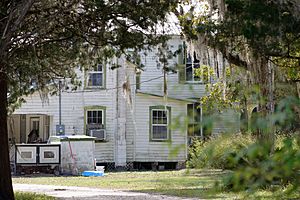Rosewood, Florida facts for kids
Quick facts for kids
Rosewood, Florida
|
|
|---|---|

House remaining in Rosewood
|
|
| Country | |
| State | |
| County | Levy |
| Time zone | UTC-5 (Eastern (EST)) |
| • Summer (DST) | UTC-4 (EDT) |
| ZIP code |
32625
|
| Area code(s) | 352 |
Rosewood is a small, unincorporated community in Levy County, Florida. It is located about 1 mile northeast of Sumner and 9 miles northeast of Cedar Key, right off State Road 24. In the early 1900s, Rosewood was a thriving African-American community. However, in 1923, a terrible event known as the Rosewood massacre led to its destruction by a white mob.
Contents
History of Rosewood

Rosewood was first settled in 1845. It was located about 9 miles east of Cedar Key, close to the Gulf of Mexico. The main business in Rosewood was timber. The name "Rosewood" came from the reddish color of the cedar wood found there.
There were two pencil mills nearby in Cedar Key. Also, several turpentine mills and a sawmill were just 3 miles away in Sumner. These businesses, along with farming citrus fruits and cotton, helped the people of Rosewood make a living. The small community grew enough to get its own post office and a train station on the Florida Railroad in 1870. However, Rosewood was never officially made into a town.
Community Changes Over Time
When Rosewood was first settled, both black and white families lived there. By 1890, most of the cedar trees had been cut down, so the pencil mills closed. Many white residents then moved to Sumner. By 1900, most of the people living in Rosewood were black. The nearby village of Sumner was mostly white, and for a while, the two communities got along well.
Rosewood's population was largest in 1915, with 355 people. Two black families, the Goins and Carrier families, were very important in the community. The Goins family helped bring the turpentine industry to the area. Before the attacks, they owned the second-largest amount of land in Levy County. The Carrier family was also large and involved in logging. By the 1920s, almost everyone in Rosewood was related in some way, making it a very close-knit community.
Life in Rosewood Before 1923
In the early 20th century, many parts of the Southern United States, including Florida, had racial segregation laws called Jim Crow laws. These laws meant that black and white people had separate public places and transportation. In Rosewood, black and white residents created their own community centers.
By 1920, the people of Rosewood were mostly self-sufficient. They had three churches, a school, and a large Masonic Hall. There was also a turpentine mill, a sugarcane mill, and a baseball team called the Rosewood Stars. The village had two general stores, one of which was owned by a white person. Rosewood had about a dozen two-story wooden homes and many smaller houses. Some families even owned pianos and organs, showing they were doing well. People who survived Rosewood often remember it as a happy place. In 1995, a survivor named Robie Mortin, who was 79, said, "Rosewood was a town where everyone's house was painted. There were roses everywhere you walked. Lovely."
Economy of Rosewood
Early Industries and Decline
Before 1923, Rosewood's economy was based on its natural resources. The main business was timber, especially cedar wood. There were also turpentine mills and a sawmill nearby. People also farmed citrus fruits and cotton.
In 1923, during the tragic Rosewood massacre, almost the entire town was destroyed. Only John Wright's General Store remained standing. After most of the people had to leave Rosewood, the turpentine industry, which had been very profitable, began to disappear. This was partly because new, man-made products were being created that replaced turpentine. By 1950, the turpentine industry was almost completely gone.
Rosewood Today
Since the 1950s, some new businesses have started in the Rosewood area. These include a general store, fisheries, and charter tours. There are also farms for clams, oysters, and other types of shellfish. Other businesses include agricultural farms, restaurants, storage places, and a small airfield. Several neighborhoods have also been built around these businesses.
Images for kids
-
This pencil mill in Cedar Key was an important part of local industry.


